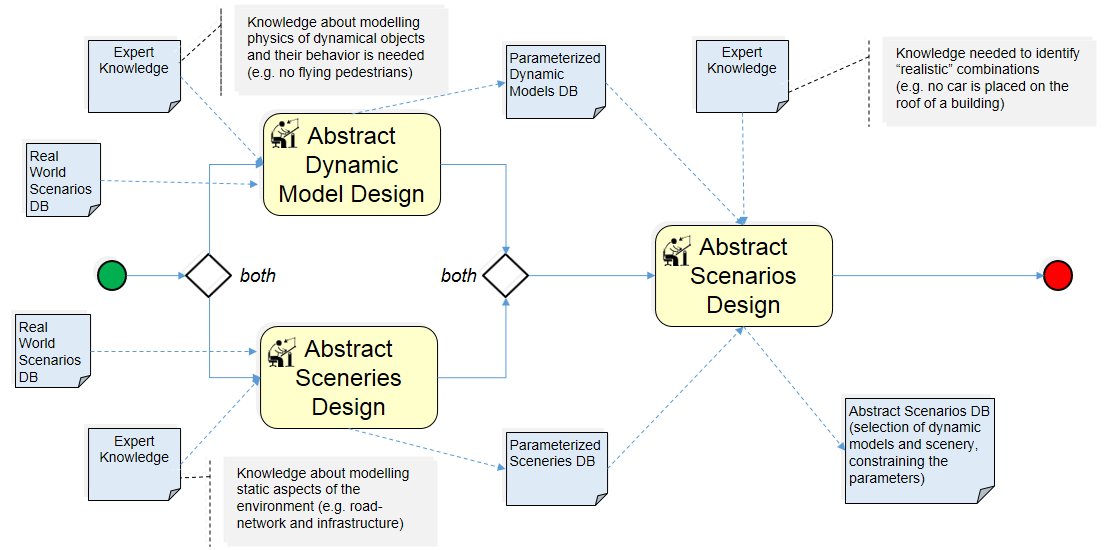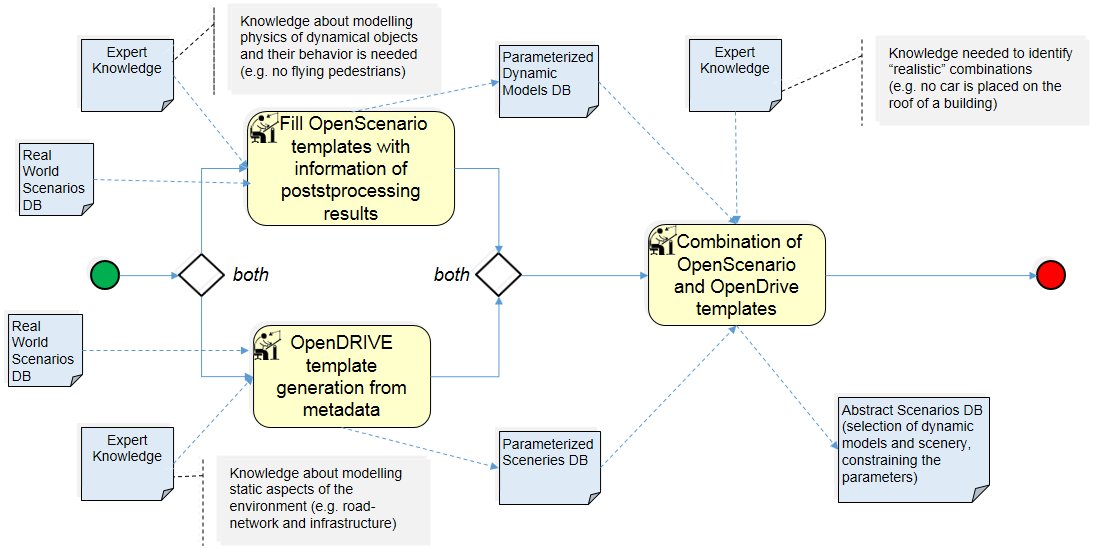Abstract Scenarios DB Design
Meta-Information
Origin: Eike Möhlmann / OFFIS, Anja Sieper / OFFIS
Written: May 2019
Purpose: Creation of a set of abstract scenarios and models which should represent the real world.
Context/Pre-Conditions: Level of abstraction of collected real word data and scenarios catalog has to match, such that it enables a later mapping. Additionally, when considering recorded data, the quality of the recording process should be known. And that data should not be used to validate the catalog.
To consider: The generation of the scenarios catalog requires detailed expert knowledge of dynamic and static aspects of relevant scenarios. The individual process steps can also be done semi-automatic, e.g., by model fitting, automatic scenario clustering.
Structure

Participants and Important Artefacts
Real World Scenarios DB: Scenarios that have been reconstructed from annotated/labelled real word recordings/observations/measurement.
Abstract Scenarios DB: A set or catalog of abstract scenarios assumed to be a proxy for the real world, e.g. left turns on two lane city road intersection.
Scenario editor (expert): Generates dynamic models and static sceneries and compiles them into formalized abstract scenarios.
Parameterized Dynamic Models DB: A set of dynamic models describing the possible behavior of traffic participants such as vehicles, bikes, pedestrians, wheelchairs, skaters, kids, etc.
Parameterized Sceneries DB: A set of abstract sceneries including road topologies, road infrastructure, traffic signs, etc.
Abstract Scenarios DB: A set of combinations of dynamic models with a static scenery and ranges/distributions on the parameters. Each combination is an abstract scenario describing possibly infinitely many concrete scenarios.
Actions/Collaborations
Abstract Dynamic Model Design: Process of creating a (mathematical) model describing the dynamics of the different objects within the scenario (vehicle dynamics, pedestrian dynamics, etc.).
Abstract Sceneries Design: Process of creating a (mathematical) description of the static aspects within the scenario (e.g. road topology, traffic light positions, walls, trees, etc.).
Abstract Scenarios Design: Process of combining dynamic and static aspects (see above) thereby describing all relevant aspects of a scenario.
Discussion
Benefits: Derivation of an abstract scenarios catalog/DB which can be used for a continuous design process including the (semi-)virtual testing.
Comment: Until now the quality of the resulting scenarios catalog depends on the experts or used automatization. If the quality is not yet known, then an additional qualification step “Representativeness Checking” is needed.
Application Examples
This pattern was applied to generate a domain specific scenarios catalog/database usable for requirement analysis and (semi-)virtual verification in following use cases:
ENABLE-S3 UC2 “Intersection Crossing using ACPS”
ENABLE-S3 UC6 “Valet Parking”

Relations to other Patterns
| Pattern Name | Relation* |
| Abstract Scenarios Mining | This pattern derives the abstract scenarios from those identified in the (super-pattern) Abstract Scenarios Mining |
* “this pattern” denotes the pattern described here, “that pattern” denotes the related pattern
